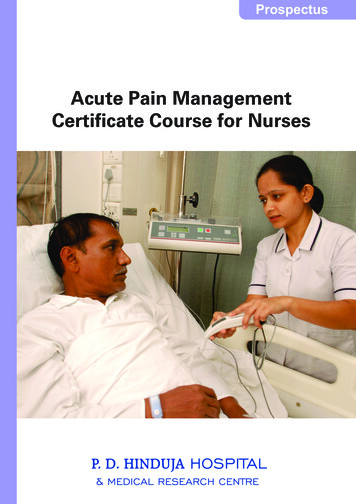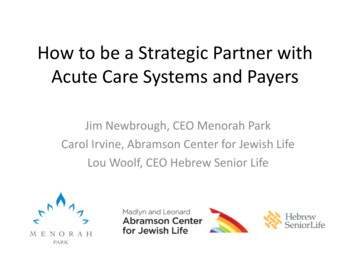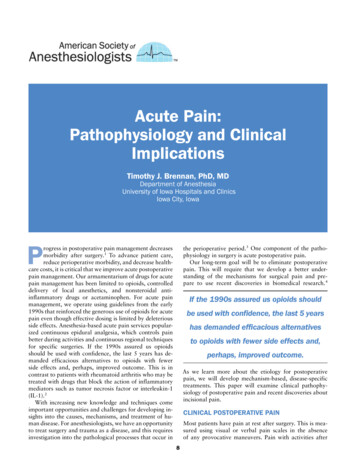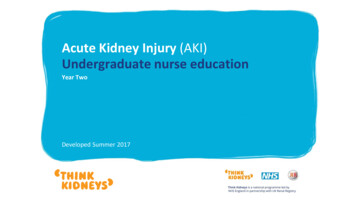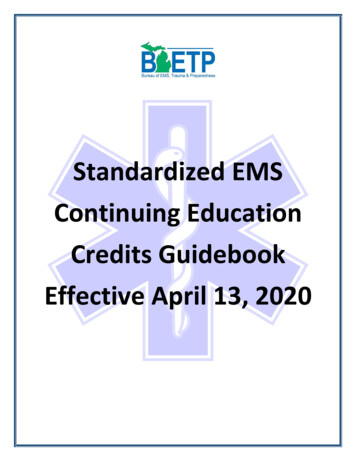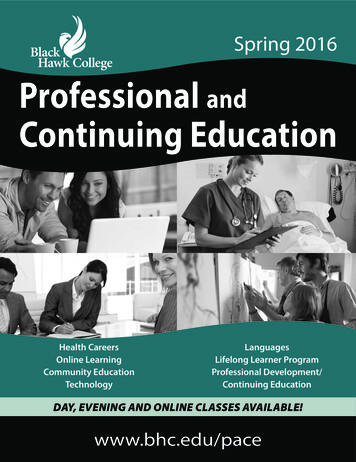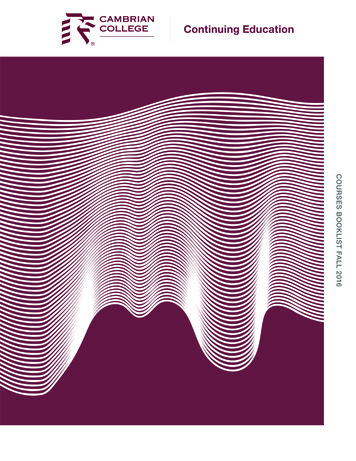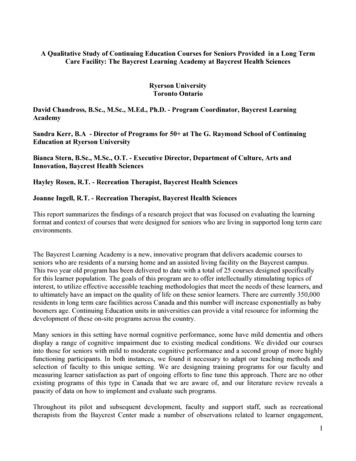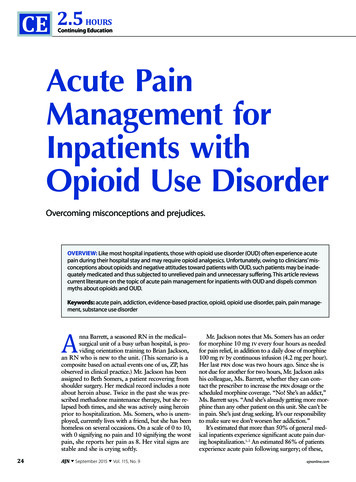
Transcription
CE 2.5HOURSContinuing EducationAcute PainManagement forInpatients withOpioid Use DisorderOvercoming misconceptions and prejudices.OVERVIEW: Like most hospital inpatients, those with opioid use disorder (OUD) often experience acutepain during their hospital stay and may require opioid analgesics. Unfortunately, owing to clinicians’ misconceptions about opioids and negative attitudes toward patients with OUD, such patients may be inadequately medicated and thus subjected to unrelieved pain and unnecessary suffering. This article reviewscurrent literature on the topic of acute pain management for inpatients with OUD and dispels commonmyths about opioids and OUD.Keywords: acute pain, addiction, evidence-based practice, opioid, opioid use disorder, pain, pain management, substance use disorderAnna Barrett, a seasoned RN in the medical–surgical unit of a busy urban hospital, is pro viding orientation training to Brian Jackson,an RN who is new to the unit. (This scenario is acomposite based on actual events one of us, ZP, hasobserved in clinical practice.) Mr. Jackson has beenassigned to Beth Somers, a patient recovering fromshoulder surgery. Her medical record includes a noteabout heroin abuse. Twice in the past she was pre scribed methadone maintenance therapy, but she re lapsed both times, and she was actively using heroinprior to hospitalization. Ms. Somers, who is unem ployed, currently lives with a friend, but she has beenhomeless on several occasions. On a scale of 0 to 10,with 0 signifying no pain and 10 signifying the worstpain, she reports her pain as 8. Her vital signs arestable and she is crying softly.24AJN September 2015 Vol. 115, No. 9Mr. Jackson notes that Ms. Somers has an orderfor morphine 10 mg iv every four hours as neededfor pain relief, in addition to a daily dose of morphine100 mg iv by continuous infusion (4.2 mg per hour).Her last prn dose was two hours ago. Since she isnot due for another for two hours, Mr. Jackson askshis colleague, Ms. Barrett, whether they can con tact the prescriber to increase the prn dosage or thescheduled morphine coverage. “No! She’s an addict,”Ms. Barrett says. “And she’s already getting more mor phine than any other patient on this unit. She can’t bein pain. She’s just drug seeking. It’s our responsibilityto make sure we don’t worsen her addiction.”It’s estimated that more than 50% of general med ical inpatients experience significant acute pain dur ing hospitalization.1, 2 An estimated 86% of patientsexperience acute pain following surgery; of these,ajnonline.com
43% describe their pain as moderate, 24% as severe,and 23% as extreme.3 Given that nearly 2 millionAmericans ages 12 or older either abused or were de pendent on opioid painkillers in 2013,4 it’s likely thata proportion of general medical and surgical inpa tients will have opioid use disorder (OUD), thoughtheir admission may be entirely unrelated to druguse. During hospitalization, such patients are as likelyto experience acute pain from surgery, injury, or dis ease as any other inpatient, and in many cases opioidsmay be the most effective and appropriate means bywhich to manage their pain. Such patients, however,may receive insufficient analgesia as a result of clini cian misconceptions about opioids or prejudice to ward patients with OUD.5The American Nurses Association describes nursingas the “prevention of illness and injury, alleviation ofsuffering . . . , and advocacy in the care of individuals,families, communities, and populations.”6 Nurses havea moral and professional obligation to all patients whoexperience acute pain, including those with OUD. Sim ilarly, the 2012 American Society for Pain Manage ment Nursing position statement on pain managementin patients with substance use disorders affirms that“every patient with pain, including those with sub stance use disorders, has the right to be treated withdignity, respect, and high-quality pain assessment andmanagement.”7Unfortunately, patients with OUD who ask forpain medication may be perceived as seeking drugsto support an addiction. In such cases, rather than rely ing on evidence-based recommendations for painmanagement, clinicians may be guided by a fear ofcausing overdose or fueling addictive behaviors, orthey may be inappropriately adhering to a “toughlove” approach. The patients’ pain may then remainundertreated, which can place them at risk for sig nificant physical and psychological consequences.To counteract such often well-intentioned but unin formed and potentially harmful pain managementpractices, it’s necessary for nurses, NPs, and physi cians to understand how to knowledgeably assessacute pain in hospitalized patients with OUD.This article reviews current literature on acute painmanagement for inpatients with OUD, dispels com mon myths about opioids and OUD, and discussescommon misconceptions among nurses about acutepain management in patients who have addictive dis orders. Since inpatient and outpatient pain manage ment differs significantly in terms of opportunities toclosely monitor vital signs, assess patients for sedationor respiratory depression, and ensure that medicationsare taken as directed, this article focuses exclusively onthe use of opioids to treat acute pain in the inpatientsetting.ajn@wolterskluwer.comImage Graham Dean / Corbis.By Zoe Paschkis, RN, and Mertie L. Potter, DNP, PMHNP-BC, PMHCNS-BCLITERATURE SEARCHTo identify relevant literature, we performed a key word search of the Ovid, MEDLINE, and CINAHLdatabases, using the following words and phrases invarious combinations: inpatients, opioid, opioid analgesics, opioid use disorder, opioid-related disorders,substance-related disorders, addiction, pain, acutepain, pain management, nursing care, nurse attitudes,and attitude of health personnel. We limited our data base search to peer-reviewed articles written in Englishbetween 2000 and 2015. We then searched throughreference lists of relevant journal articles. To this, weadded several works written by authorities on thesubject of pain management (some written before2000), guidelines and position statements developedby national organizations concerned with pain man agement, and a seminal work on the nature of suf fering.AJN September 2015 Vol. 115, No. 925
THE IMPORTANCE OF PAIN MANAGEMENTA number of organizations, including the Joint Com mission and the American Pain Society, have publishedpain management standards and recommendationsthat underscore patients’ right to pain relief, the im portance of conscientious pain assessment, and theneed to reassess and adjust the pain managementplan as appropriate.8, 9 Pain management is evalu ated through the use of quality indicators, such asthe frequency of pain assessment and the degree towhich pain is prevented and controlled. Effective painmanagement is critical to patient comfort and heal ing.10Prevalence and consequences of unrelieved pain.Acute pain is frequently undertreated.3, 11, 12 Studiessuggest that more than 60% of inpatients experienceincomplete or inadequate pain relief.12, 13 Proposed ex planations for the undertreatment of pain include 12, 14 infrequent or inappropriate pain assessment. underprescription of pain medication. underadministration of as-needed pain medica tion. inadequate instruction in nursing and medicalschools in pain management. inadequate clinician knowledge of opioid dose ti tration. time constraints. poor adherence to pain management guidelines. concerns about opioid-related adverse effects,such as respiratory depression, sedation, tolerance,and addiction. the lack of an efficient means by which to requestnew or changed analgesic orders.defines OUD—a specific subset of substance usedisorder—as a “problematic pattern of opioid useleading to clinically significant impairment or dis tress,” as indicated over the course of a year by theoccurrence of at least two of 11 criteria, including,for example, craving, use of increasing amounts ofthe drug over time, repeated unsuccessful attempts tocontrol use, and continued use despite social or in terpersonal harm. (For all 11 criteria, see http://bit.ly/1HQyThD.) A diagnostic feature of OUD is thatit reflects “compulsive, prolonged self-administrationof opioid substances that are used for no legitimatemedical purpose or, if another medical condition ispresent that requires opioid treatment, that are usedin doses greatly in excess of the amount needed forthat medical condition.”17 Once OUD has been diag nosed, its treatment may include addiction counsel ing, cognitive behavioral therapy, support groups,and maintenance therapy with an opioid agonist, suchas methadone.18Despite certain crucial differences, patients who useopioids to treat chronic pain and people with OUDshare some similarities. Both may become physicallydependent on opioids and develop a high opioid toler ance, and both are at risk for stigmatization by healthcare professionals.15, 19, 20 Physical dependence on opi oids may manifest in a withdrawal syndrome pro duced by “abrupt cessation, rapid dose reduction,decreasing blood level of the drug . . . or administra tion of an antagonist.”21 Whether opioid dependenceand tolerance are owing to long-term use for chronicpain or to an addictive disorder, acute pain should betreated similarly in the inpatient setting.Some maintain that addiction is a choice and not a disease.OUD is thus often seen not as a disease to be treated but as abehavior to be punished.Unrelieved pain is a health problem with potentiallyfar-reaching consequences. Inadequately managedacute pain can cause neural changes that precipitatechronic pain and its attendant risks of anxiety, de pression, social isolation, poor health outcomes, andmistrust of the medical system (see Figure 1).15, 16 Un dertreating acute pain can also lead to atelectasis,poor wound healing, respiratory infection, sleep dis turbances, impaired mobility, thromboembolism, pro longed recovery time, and extended hospital stays.DIFFERENTIATING OUD FROM LONG-TERM OPIOID USEThe fifth edition of the Diagnostic and StatisticalManual of Mental Disorders, published in 2013,26AJN September 2015 Vol. 115, No. 9ADMINISTERING OPIOIDS TO INPATIENTS WITH OPIOIDTOLERANCEThe first step in managing pain for all patients shouldbe to validate and acknowledge the existence of theirpain and assure them they will receive adequate anal gesia.22 The second step should be to perform a thor ough pain assessment, addressing15, 23 pain intensity (using a numeric or visual analogscale, for example). pain quality (“stabbing” or “aching,” for exam ple). pain location. aggravating factors. alleviating factors.ajnonline.com
Opioidrelated mediaattentionPrejudiceMisconceptions amongnursesUndermedication ofpatientUnrelieved painNurses’negative priorexperienceLack offormaltraining Chronic painDepressionAnxietySocial isolationPoor health outcomesMistrust of health care systemFigure 1. Potential Causes and Consequences of Inadequately Managed Acute Pain associated factors (such as nausea, vomiting, orconstipation). timing of the pain (onset, duration, and frequency). goals for pain level and function.Opioids, if an appropriate treatment choice, shouldnot be withheld from a patient on the basis of a co morbid addictive disorder.15, 24Opioid dosing. When caring for patients who arephysically dependent on opioids—whether depen dence stems from prior chronic pain treatment orOUD—it is necessary to know the type and quantityof opioid they were consuming prior to hospitaliza tion so that an equivalent (equianalgesic) dose can beadministered by an appropriate route to cover theirbaseline opioid requirement.15, 25 Several equianalge sic conversion calculators for opioids can be foundonline and on the Web sites of pain programs, suchas the Sidney Kimmel Comprehensive Cancer Centerat Johns Hopkins Center for Cancer Pain Research(www.hopweb.org). The calculator can be used, forexample, to determine the postoperative dosage of ivmorphine that would cover the baseline requirementof a surgical patient who had been taking oxycodone280 mg by mouth daily prior to hospitalization. A20-mg dose of oxycodone by mouth is equivalentto a 10-mg dose of morphine iv. Following surgery,therefore, the patient should be given a baseline doseof morphine 140 mg iv, and additional opioid analge sia would be required on top of that to control acutepostsurgical pain.15As far as we know, there are no evidence-basedguidelines for determining inpatient opioid dosage inan opioid-tolerant patient based on the opioid dosagefollowed prior to hospitalization; however, several painexperts have made recommendations. Drew and St.Marie suggest that it’s reasonable to begin titrating opi oids at a level that is 50% to 100% greater than base line use, but they also stress that precise medicationreconciliation—in which the timing, formulation, anddosage are verified—is essential; reviewing prescriptionajn@wolterskluwer.cominformation alone is insufficient.15 Carroll and col leagues note that postoperative opioid requirementsmay be two to four times greater for an opioid-tolerantpatient than for an opioid-naive patient.26 While thesesuggestions provide a useful frame of reference, it’s im portant to remember that opioid doses must be indi vidualized and titrated to analgesic effect.25, 27 There isno one dose that is safe and effective for every patient.Although opioid analgesics are often indicated foracute pain management, they are not without risk. Inaddition to nausea and constipation, opioids can causeover-sedation and respiratory depression. In overdose,they may be lethal. Careful titration is required tomaximize pain relief while minimizing adverse effects.Other variables to consider when managing acutepain in patients with OUD include formulation, route,and timing of opioid medications. Although the choiceof formulation and route depends on multiple factors,Drew and St. Marie suggest starting with long-actingop
substance-related disorders, addiction, pain, acute pain, pain management, nursing care, nurse attitudes, and attitude of health personnel. We limited our data base search to peer reviewed articles written in English between 2000 and 2015. We then searched through reference lists of relevant journal articles. To this, we added several works written by authorities on the subject of pain .
